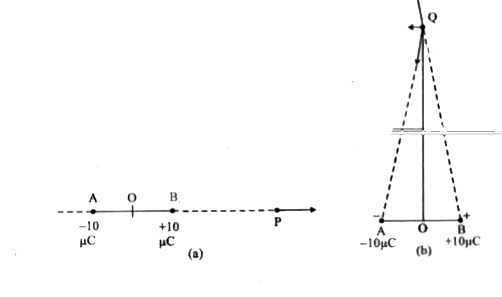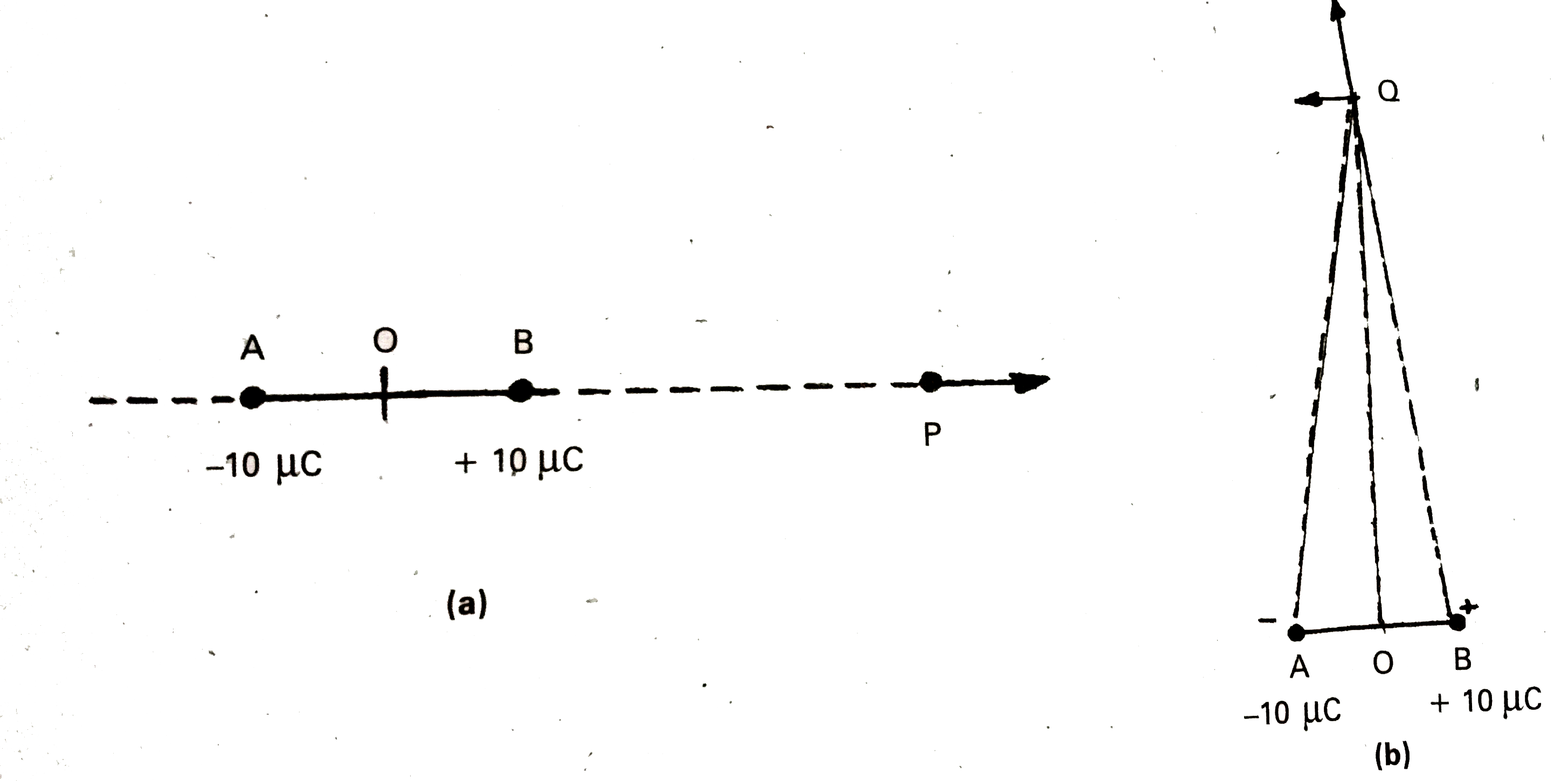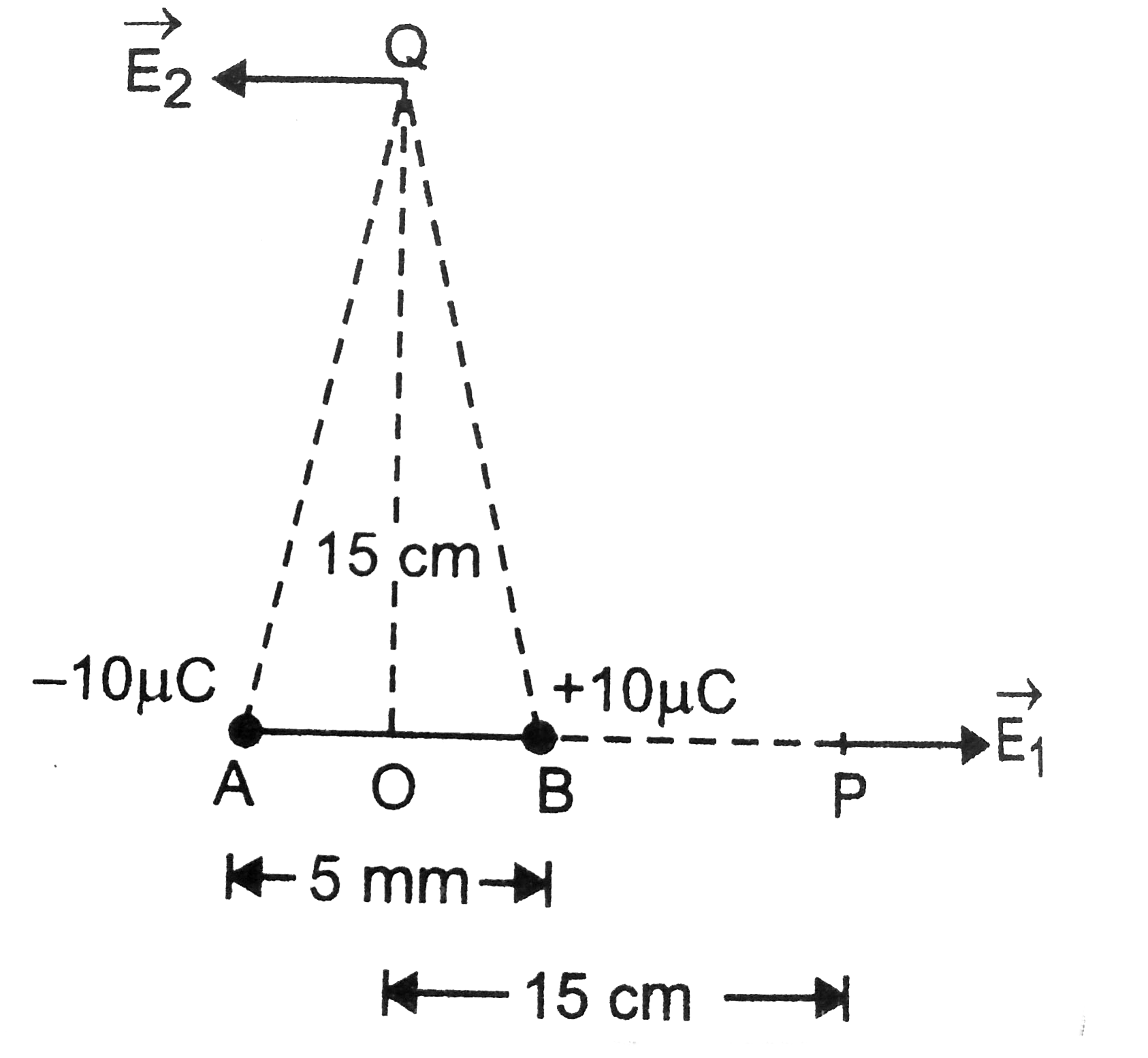Two charges ±10μC are placed 5.0 mm apart. Determine the electric field at (a) a point P on the axis of the dipole 15 cm away from its centre O on the side of the positive charges, as shown in Fig. (a) and (b) be a point Q, 15 cm away from O on a line passing through O and normal to the axis of the dipole, as shown in Fig (b).  Solution in Tamil
Solution in Tamil
(a) field at p due to charge + 10 μc
=10−5c4π(8.854×10−12C2N−1m−2)×1(15+0.25)2×10−4m2
=3.86×106NC−1 along PA
in this example the ratios OP/OB is quite large (=60) thuis we can expect to get approximately the saem result as above by directly using field at a distance r form the centre on the axis of the dipole has a magnitude field at Q due to charge =-10 μc at a
clearly the components of these two forces with equal magnitudes cancel along the direction OQ but add up along the direction parallel to BA therefore the resultant electric field at Q due to the two charges at A and B is
=1.33×105NC−1 along BA
as in (a) we can expect to get approximately the same result by directly using the formula for dipole field at a point on the normal to the axis of the dipole
E=P4πε0r3
=1.33×105NC−1
The direction of electric field in the this case is opposite to the direction of the dipole maoment vector again the result agrees with that obtained before
Topper's Solved these Questions
- BOOK - NCERT TAMILCHAPTER - ELECTRIC CHARGES AND FIELDS EXERCISE - EXERCISES34videos
ELECTRIC CHARGES AND FIELDS
- BOOK - NCERT TAMILCHAPTER - DUAL NATURE OF RADIATION AND MATTEREXERCISE - EXERCISES41videos
DUAL NATURE OF RADIATION AND MATTER
- BOOK - NCERT TAMILCHAPTER - ELECTROMAGNETIC INDUCTIONEXERCISE - ADDITIONAL EXERCISES7videos
ELECTROMAGNETIC INDUCTION
Similar Questions
What is the force between two small charged spheres having charges of 2×10−7Cand3×10−7C placed 30cm apart in air ?
03:06View SolutionFind the (a) maximum frequency and (b) minimum wave-length of X-rays produced by 30 kV electrons. Given, h=6.63×10−34Js.
03:45View SolutionSuppose the loop in Textual Exercise 4 is stationary but the current feeding the electromagnet that produces the magnetic field is gradually reduced so that the field decreases from its initial value of 0.3 T at the rate of 0.02Ts−1 .If the cut is joined and the loop has a resistance of 1.6Ω how much power is dissipated by the loop as heat ? What is the source of this power ?
08:25View SolutionTwo charges +- 10 mu C are placed 5*0 mm apart. Determine the electric field at (a) point P on the axis of dipole 15 cm away from its center on the side of the positive charge. As shown in Figure and at (b) a point Q. 15 cm away form O on a line passing through O and a line passing through O and normal to the axis of the dipole as shown in Fig.
04:48View SolutionTwo charges +20muC and -20muC are placed 10mm apart. The electric field at point P, on the axis of the dipole 10 cm away from its centre O on the side of the positive charge is
05:01View Solution±10μc के दो आवेश एक - दूसरे से 5.0 mm की दुरी पर स्थित हैं । (a ) इस द्विध्रुव के अक्ष पर द्विध्रुव के केंद्र O से चित्र (a ) में दर्शायें अनुसार , धनावेश की और 15 सेमी दुरी पर स्थित किसी बिंदु p पर तथा (b ) द्विध्रुव के अक्ष के अभिलंबवत O से चित्र (b ) के अनुसार गुजरने वाली रेखा से 15 सेमी दुरी पर स्थित किसी बिंदु Q पर विद्युत - क्षेत्र का मान ज्ञात कीजिए ।
 03:06View Solution
03:06View SolutionTwo charges 10μC are placed 5.0 mm apart. Determine the electric field at a point P on the axis of the dipole 15 cm away from its centre O on the side of the positive charge, as shown in Fig.
 04:54View Solution
04:54View SolutionTwo charges 10 muC are placed 5.0 mm apart. Determine the electric field at a point Q, 15 cm away from O on a line passing through O and normal to the axis of the dipole, as shown in Fig.
View SolutionTwo charges ±10μC are placed 5⋅0mm apart. Determine the electric field at (a) point P on the axis of dipole 15cm away from its center on the side of the positive charge. As shown in Figure and at (b) a point Q. 15cm away form O on a line passing through O and a line passing through O and normal to the axis of the dipole as shown in Fig.
 08:35View Solution
08:35View SolutionTwo charges ±10μC are placed 5.0 mm apart. Determine the electric field at (a) a point P on the axis of the dipole 15 cm away from its centre O on the side of the positive charges, as shown in Fig. (a) and (b) be a point Q, 15 cm away from O on a line passing through O and normal to the axis of the dipole, as shown in Fig (b).
 02:59View Solution
02:59View SolutionTow charges pm10 mu C are placed 5.0 mm apart determine the electric field at (a) a point p on the axis of the dipole 15 cm away from its centre o ont the side of the positive charge as (a) and (b) a point q 15 cm away from o on a line passing through o and normal to the axis of the dipole as
02:44View SolutionTow charges pm10 mu C are placed 5.0 mm apart determine the electric field at (a) a point p on the axis of the dipole 15 cm away from its centre o ont the side of the positive charge as (a) and (b) a point q 15 cm away from o on a line passing through o and normal to the axis of the dipole as
03:02View SolutionTwo charges ±10μC are placed 5⋅0mm apart. Determine the electric field at (a) point P on the axis of dipole 15cm away from its center on the side of the positive charge. As shown in Figure and at (b) a point Q. 15cm away form O on a line passing through O and a line passing through O and normal to the axis of the dipole as shown in Fig.
 02:16View Solution
02:16View SolutionTwo charges of dipole +- 10 mu C are placed 1mm apart. Determine the electric field at a point on the axis of the dipole 10 cm away from its centre and at 10 cm away from centre on the equator of the dipole.
02:57View SolutionTow charges ±10μ C are placed 5.0 mm apart determine the electric field at (a) a point p on the axis of the dipole 15 cm away from its centre o ont the side of the positive charge as (a) and (b) a point q 15 cm away from o on a line passing through o and normal to the axis of the dipole as
 02:41View Solution
02:41View SolutionTwo charges +20muC and -20muC are placed 10mm apart. The electric field at point P, on the axis of the dipole 10 cm away from its centre O on the side of the positive charge is
03:52View Solution

